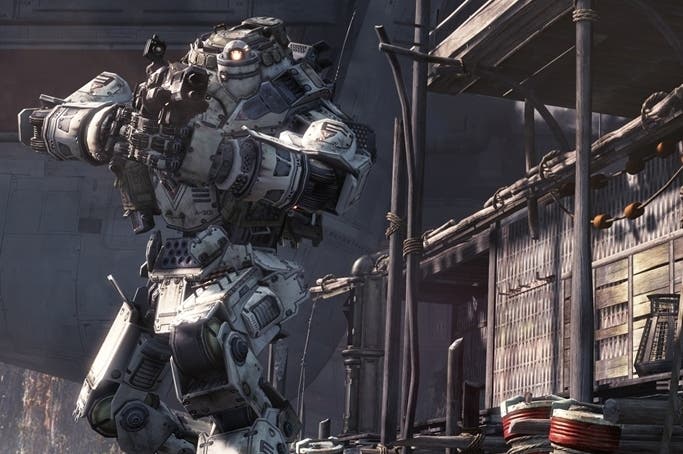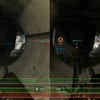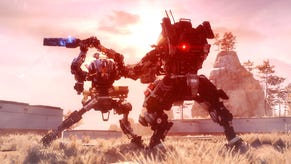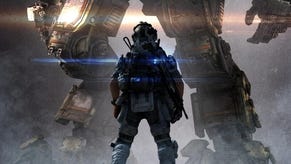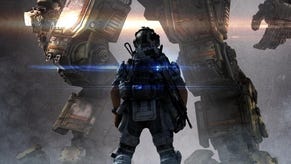Face-Off: Titanfall on Xbox 360
Digital Foundry's exhaustive cross-gen comparison between PC, Xbox 360 and Xbox One.
The shroud of mystery surrounding Titanfall on Xbox 360 is, at last, dispelled. Without a single image to show for its progress - and a month delay beyond the Xbox One and PC launches - doubts began to surface as to the project's well-being. But with the game hitting store shelves this week, the actual result is surprising for an unexpected reason: the core features of Respawn Entertainment's blockbuster are successfully distilled, and this is very much Titanfall at its heart. However, given that it's running on a console eight years the Xbox One's senior, just what technical trade-offs were needed to pull off such a feat?
In charge of this task is Bluepoint Games, famed for its expert HD remastering of franchises such as Metal Gear Solid and God of War. However, the logistics of working on Titanfall - a game for which core development was still ongoing during its porting effort - makes it the studio's most ambitious project so far. The Source Engine is still the game's technical foundation, just as with Respawn's master copy, but the team has replaced the existing world renderer with its own system built to suit the 360's restrictive memory budget, and has also completely revised the game's approach to streaming assets.
As with 2012's Halo 4, a hard disk is required for background caching of data as you play. Where the Xbox One commits all texture and vertex data to its 8GB RAM, the 360 code instead relies on streaming assets from both DVD and hard disk simultaneously. This means throughput is divided, where higher-grade textures are pulled from DVD, the slower access speed of which causes noticeable normal map pop-in at times. Look close in amongst the action, for example, and you'll catch a clay-like appearance to Titans as they trundle past. Even so, on balance it's a respectable workaround given the team's access to just a tenth of the RAM available on Xbox One.
"The 360 version intelligently draws its assets from both HDD and DVD, which helps overcome its significant memory limitations."
Alternative comparisons:
The 360's architecture is also tailored to carefully when it comes to resolution. A 1040x600 native frame-buffer is deployed, which falls curiously close to the number used in Infinity Ward's earlier Call of Duty titles. This is for good reason: it's a figure that carries the advantage of fitting within the console's 10mb EDRAM limit, a fast scratch-pad that opens up 2x MSAA to developers at a zero performance penalty.
This is used to full effect for Titanfall 360, and the end result isn't far removed from the Call of Duty games in terms of overall image quality. However, for long views of maps like Fracture, it's easy to pick out the degradation compared to the PC version running at 1080p - and even the Xbox One at 1408x792. There's a lack of definition to skybox details as a result, although fortunately all the HUD elements are still presented in full 1280x720.
Texture assets and geometry inevitably need the nip-tuck as well. From a memory standpoint, the ability to draw in textures as needed helps massively, but garish-looking normal maps do crop up in more complex areas like Fracture. There's a pixellated appearance to walls and ground surfaces that stands at odds with other objects, which can use markedly higher-quality maps. Geometry, on the other hand, is a very close match for the Xbox One and PC versions, with meshes mainly downgraded a step for objects in animation, or with dynamic properties.
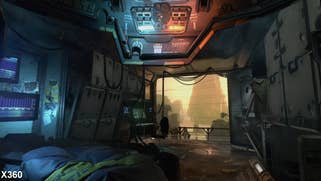
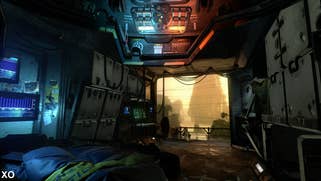


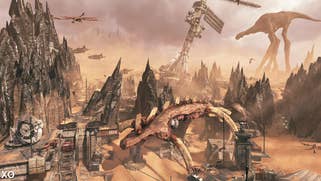



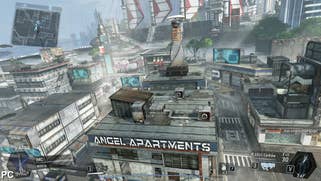
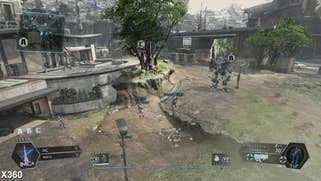

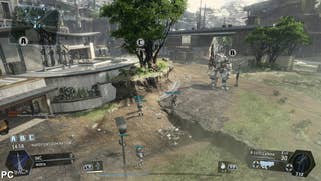
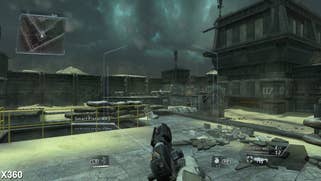

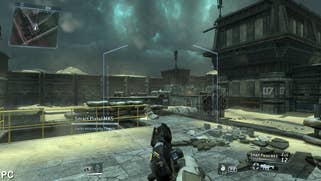
But the most immediately eye-catching difference is to the game's lighting. Here the 360 is using a simplified, static lighting model which relies solely on pre-baking shadows around a level. Characters still produce shadows dynamically, with a much fainter contour to them than the rich outlines on Xbox One, but in a curious twist, these are no longer affected by an obvious shadow-filtering cascade. In all, the changes make the world appear altogether brighter, albeit with sharper shadows at a distance - a worthwhile trade-off given the huge savings in graphics processing.
Overall playability is identical to the Xbox One and PC releases though, where all the modes, character abilities and in-game player counts are strictly upheld. AI characters are handled by the same Azure servers as the other versions, freeing up CPU processing power for other tasks. Reductions in this area are minor, with a reduced grunt count affecting the Last Titan Standing mode alone. It's a necessary design choice in order to keep the frame-rate in check - particularly given the demands of this mode - and one that barely goes noticed due to the heightened scale of the 6v6 action. Elsewhere, decorative extras such as flying dragons in the Boneyard level are also reduced in number, though again this is difficult to spot without a point of comparison.
For Xbox One, the screen is often filled with a surplus of alpha effects and particles. On 360 there's little memory bandwidth to spare for these extravagances, meaning a cut in quality is felt hugely in this area. Explosions bursting from downed Titans appear as a giant, sun-kissed blotches on-screen, and smoke appears like a sheet of grey; it's a deficit in detail which sticks out especially when hijacking a Titan and firing a gun at close range. Fortunately, there's little noticeable difference for water shaders, or heat haze under spaceships, suggesting these are a lesser issue for the platform.
"On 360 there's limited memory to spare for the game's alpha effects, and a noticeable cut in quality is felt in this area."
Alternative analysis:
Just as with the Xbox One release, the bigger issue with any surge of alpha effects is the dips in performance they can bring. For this release, gone is even a hope of holding at 60fps, and instead the 360 pushes out between 30 and 50fps when the frame-rate is unlocked. It's an uneven level of response that makes control less dependable than a perfectly locked 60fps, though still much smoother than a cap at 30fps.
Indeed, it's to the 360's credit that drops below 30fps are so unusual. It carries itself very well when considering the Xbox One release lurches in the 40fps range while under stress - particularly so in Last Man Standing mode, where all mechs engage on a battlefield at once.
The downside to this unlocked approach is the emergence of tearing, streaking across the screen whether you're in the thick of the action or not. By comparison, the Xbox One utilises an adaptive v-sync approach, where the image integrity is at least maintained up until it drops below the ideal 60fps line. Unfortunately, there's no such relief on 360, where it's a constant blight on the image - unless you have a look to the options menu.
"It's remarkable that the older 360 hardware is capable of this range of performance, but it comes at the cost of copious, ever-present tearing. "
A 30Hz toggle is available to 360 owners, allowing for a completely even, v-synced cap at 30fps on Xbox 360. We put this to the test across all modes, and find that this works well in averaging our controller latency to a single straight line at 33ms. There are hiccups though; for any drops below this number, tearing kicks in until the game is able to render at 30 or more frames per second.
Drops in this vein are limited to the usual problem areas - Titan duels around heavily built-up areas being the main one, which in this case causes performance as low as 22fps. It's a lower frame-rate than we see with the 30Hz mode unchecked, and produces a heavy judder effect in amongst the odd tear. As an extra option for those with an aversion to heavy tearing, then, the 30Hz mode is welcome, but the off-shoot is that control feels heavier and more laboured when it's engaged.
By following similar routes through Titanfall's campaign we're able to better gauge performance between the 360 and Xbox One. On average, the older console carries a lower rate of refresh that bears out for controller response, creating an experience that feels less smooth. The Xbox One release does have persisting issues, however, and suffers from sharp, unexpected lurches downwards - often without a clear cause. It's a comparison that ends up flattering the optimisation work on 360, while casting doubts about the suitability of the underlying tech for newer platforms.
"A performance comparison between the 360 and Xbox One versions does more to flatter the older console."
Titanfall Xbox 360: the Digital Foundry verdict
In the end, the media black-out for Titanfall 360 has turned out to be anything but a cause for concern. Bluepoint Games trims back anything it reasonably can to preserve the core features seen in the original Xbox One release, reining in texture and geometry quality until it fits the Xbox 360's technical dimensions. Even with the loss of dynamic lighting, and use of pre-baked shadows, that the game looks so close to the source material is a huge credit to the team.
The frame-rate situation is also impressive in light of it being a game designed for a far faster platform. The game's controls come across as sluggish by comparison to the Xbox One edition, and the visuals suffer greatly for the high levels of screen-tear. Regardless, it has no aspirations to hit 60fps in the first place, meaning the 30fps lock option is a very attractive alternative - and one which would sit well on Xbox One given its own current difficulties hitting 60fps at times.
But the overwhelming impression is that Titanfall, through disciplined re-engineering of its assets and systems, is now fully playable on a much older console. It's the real deal, and while not exactly a challenge for the Xbox One release in the performance stakes, the port is arguably strong enough for players to accept a lesser experience to avoid shelling out for a brand new console. That being said, performance and resolution updates on Xbox One are still pending, where widening the gap between the two could make the upgrade more tempting.
